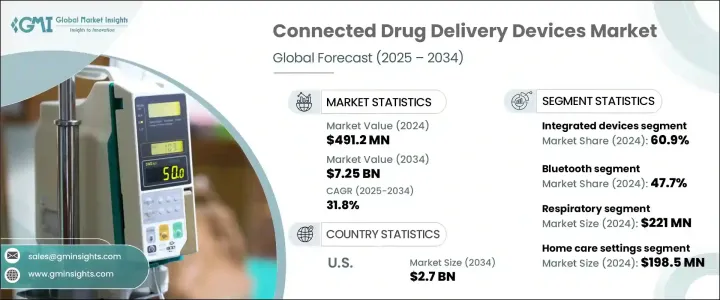
세계의 커넥티드 약물전달 디바이스 시장은 2024년에 4억 9,120만 달러로 평가되었고 2025년부터 2034년에 걸쳐 31.8%의 견조한 CAGR을 나타낼 것으로 예측되고 있습니다.
이러한 장치는 Bluetooth, Wi-Fi, 사물 인터넷(IoT) 등의 최신 기술을 통합하여 투약 관리 및 투여를 개선합니다. 르 주사기, 지능형 정제 디스펜서 등이 포함되어 있어, 모두 복약 상황을 감시하고, 복약 준수를 높이고, 환자와 헬스 케어 제공업체 간의 실시간 커뮤니케이션을 가능하게 하도록 설계되어 있습니다. 천식, 당뇨병, 심혈관 질환 등의 만성 질환의 이환율이 상승하고 있는 것이 이러한 첨단 약물 전달 시스템에 대한 수요를 촉진하고 있습니다. 이러한 문제는 비용 증가와 환자 결과의 악화를 초래합니다.

이 시장은 디바이스 유형에 따라 연결 센서와 통합형 디바이스로 구분됩니다. 치료 계획에 대한 환자의 규정 준수를 크게 개선합니다.
| 시장 범위 | |
|---|---|
| 시작 연도 | 2024년 |
| 예측 연도 | 2025-2034년 |
| 시작 금액 | 4억 9,120만 달러 |
| 예측 금액 | 72억 5,000만 달러 |
| CAGR | 31.8% |
기술을 바탕으로, 시장은 Bluetooth, 근거리 무선 통신, Wi-Fi로 나뉘어져 있습니다. Bluetooth 분야는 2024년에 47.7%로 가장 높은 수익 점유율을 차지했습니다. 만성 질환 증가에 따라 Bluetooth 대응의 스마트 흡입기, 인슐린 펜, 자동 주사기 수요가 증가하고 있습니다.
용도별로 아나필락시스, 호흡기, 심혈관, 당뇨병, 호르몬 보충, 기타 용도로 분류됩니다. 다른 호흡기 질환의 부담 증가는 연결 약물전달 솔루션의 필요성을 높이고 있습니다.
시장은 또한 최종 용도별로 병원, 진료소, 재택 케어 환경, 그 밖에 구분됩니다. 가정 건강 관리에 대한 선호도가 높아지면 연결 약물전달 시스템에 대한 수요가 늘어나고 있습니다.
미국의 커넥티드 약물전달 디바이스 시장은 2023년의 1억 5,600만 달러에서 2034년에는 27억 달러로 크게 성장할 것으로 예측되고 있습니다.
The Global Connected Drug Delivery Devices Market was valued at USD 491.2 million in 2024 and is anticipated to expand at a robust CAGR of 31.8% from 2025 to 2034. These devices integrate modern technology, such as Bluetooth, Wi-Fi, and the Internet of Things (IoT), to improve medication management and administration. They include smart inhalers, insulin pens, wearable injectors, and intelligent pill dispensers, all designed to monitor medication usage, enhance adherence, and enable real-time communication between patients and healthcare providers. The rising incidence of chronic conditions, including asthma, diabetes, and cardiovascular diseases, is fueling demand for these advanced drug delivery systems. Poor medication adherence is a persistent issue in healthcare, leading to higher costs and suboptimal patient outcomes. Connected drug delivery devices help address these concerns by ensuring proper medication intake, streamlining disease management, and reducing hospital visits.

The market is segmented based on device type into connected sensors and integrated devices. Integrated devices accounted for the largest revenue share of 60.9% in 2024. These devices, equipped with reminders, tracking features, and real-time data-sharing capabilities, significantly improve patient compliance with treatment plans. The ability to monitor medication intake remotely has strengthened their adoption across healthcare settings. The increasing prevalence of chronic illnesses has further amplified the demand for integrated drug delivery solutions.
| Market Scope | |
|---|---|
| Start Year | 2024 |
| Forecast Year | 2025-2034 |
| Start Value | $491.2 Million |
| Forecast Value | $ 7.25 Billion |
| CAGR | 31.8% |
Based on technology, the market is divided into Bluetooth, near field communication, and Wi-Fi. The Bluetooth segment held the highest revenue share of 47.7% in 2024. Low power consumption, affordability, and seamless integration with mobile health applications have driven the widespread adoption of Bluetooth-enabled drug delivery devices. These devices facilitate real-time data exchange between patients and healthcare providers, supporting remote monitoring and digital health platforms. With the rising incidence of chronic diseases, Bluetooth-enabled smart inhalers, insulin pens, and autoinjectors are witnessing increased demand. Additionally, growing investments by pharmaceutical and MedTech companies in Bluetooth-based biosensors and wearable injectors are strengthening market expansion.
By application, the market is categorized into anaphylaxis, respiratory, cardiovascular, diabetes, hormone replacement, and other uses. The respiratory segment generated the highest revenue of USD 221 million in 2024. The increasing burden of asthma, chronic obstructive pulmonary disease (COPD), and other respiratory disorders has amplified the need for connected drug delivery solutions. These devices not only improve treatment adherence but also support remote patient monitoring, strengthening the expansion of telehealth services.
The market is also segmented by end use into hospitals, clinics, home care settings, and others. The home care segment led with USD 198.5 million in revenue in 2024. The growing preference for home-based healthcare, driven by an aging population and the rising need for chronic disease management, has fueled demand for connected drug delivery systems. These devices enable self-administration and remote monitoring, allowing patients to manage their conditions more efficiently.
The U.S. connected drug delivery devices market is projected to grow significantly from USD 156 million in 2023 to USD 2.7 billion by 2034. The increasing adoption of telehealth services, particularly after the COVID-19 pandemic, has accelerated the deployment of connected devices for remote healthcare monitoring.